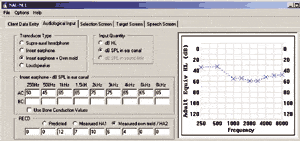A comparison of ear-canal acoustics in the most common ear coupling devices
When trying to extend the fitting range of receiver-in-the-aid (RITA) devices into the low frequencies, this study suggests that closed domes—and to a lesser degree double domes—are largely ineffective.

|
| Paul U. Teie, MS, is the professional development coordinator-East Coast for Amplifon USA, Plymouth, Minn. |
Since the advent of the open-fit mini-BTE in 2003, growth in the BTE market has been dramatic. Most recent Hearing Industries Association (HIA) data points to BTEs of all types making up 63% in the third quarter of 2009, as compared to 57% in 2008, and 23% in early 2003.
Informal polling of providers in a variety of dispensing settings suggests that 45% to 70% of current fittings are constituted by “open-fit” hearing aids.1 This typically refers to either mini-BTE hearing aids with slim tubes or receiver-in-the-canal (RIC) products. Since these types of hearing aids may or may not be “open,” depending on the status of the ear canal, a nomenclature that avoids the issue of “openness” is coming into common use: RITA (receiver-in-the-aid).
There are a number of convincing reasons that RIC and RITA style hearing aids have become so popular. The most frequently cited are reduced occlusion and fewer cosmetic concerns. It is also possible that the availability of discreet mini-BTE style hearing aids has had the effect of broadening the hearing aid market. Many providers are reporting significant increases of patients in the 30- to 50-year-old age range who have mild to moderate hearing loss.1 These hearing aids can also address precipitous high frequency hearing losses that in the recent past were considered unfittable. Perhaps the most compelling reason for their wide acceptance is patient satisfaction.2,3 Patients really like them!
Concerns have been raised that these styles of hearing aids are being overprescribed.4,5 Rose6 concluded in an informal survey that approximately 38% of open-mold fittings would have been better served by a closed-mold fitting. He also suggested that individuals fit with open molds are in danger of being under-fit. Kuk and Baekgaard7 suggested that “open fit” hearing aids may not be appropriate for all hearing aid wearers, particularly those with more than a moderate hearing loss.

|
| FIGURE 1. From left, 8 mm open dome, 10 mm open dome, 8 mm closed dome, 10 mm closed dome, 8/10 mm double dome, custom earmold with slim tube, and custom earmold with #13 tubing. |
When they were initially introduced, first RITA and later RIC hearing aids were generally recommended for hearing losses that were in the mild range for the low frequencies, and no greater than moderately severe in the high frequencies. However, more recently published fitting ranges are significantly more aggressive. In most cases, recommendations for open dome fittings are in line with the mild to moderately severe criteria, but recommendations for closed-dome or double-dome fittings extend the ranges considerably. In a recent round table discussion, a panel of experts universally suggested that manufacturers’ recommended fitting ranges were overly optimistic.8
Data is emerging that some of the occluding non-custom ear coupling devices (ie, closed and double domes) do not provide as much low frequency gain as expected. A recent study by Blau and his colleagues9 suggested that some of the more commonly used ear coupling systems have less of an effect on low frequency amplification than expected.
The purpose of the current investigation is to determine the ear canal acoustics of some of the more common ear coupling devices in a RITA hearing aid.
Procedure
A fully featured RITA hearing aid from a major hearing aid manufacturer was programmed for a flat 45 dBHL hearing loss to an NAL-NL1 prescriptive target with no reduction for acclimatization. The hearing aid was programmed to a first fit, and no attempt was made to fine-tune the response. The response of the hearing aid was verified in 9 ears (6 male and 3 female). The ear couplings shown in Figure 1 were evaluated by means of an AudioScan RM500SL real-ear analyzer using the Speechmap protocol with a calibrated speech signal delivered at 65 dBSPL:
- Open dome (8 or 10 mm)
- Closed dome (8 or 10 mm)
- Double dome (8 or 10 mm)
- Custom earmold with slim tube
- Custom earmold with regular #13 slim tubing

|
| FIGURE 2. Open dome, 9 ears. |

|
| FIGURE 3. Closed dome, 9 ears. |
Results
Results of probe tube measurements were predictable for some of the conditions. For example, the open-dome condition showed considerably less low frequency output than did the custom earmold conditions. The responses for the closed dome and double dome, on the other hand, did not conform to prior expectations. These domes are meant to occlude the ear canal and provide more low frequency gain or, in some instances, reduce the likelihood of feedback. The feedback issue was not addressed in the current investigation. However, the degree of increase in output in the low frequencies for the closed and double domes was less than might have been expected.
In the open-dome condition (Figure 2), virtually no gain is present below 2000 Hz. With the exception of Subject A, high frequency responses approached or, in some cases, exceed target. Note that in this and subsequent data, there is a consistent “notch” in the response at 1500 Hz.
In the closed-dome condition (Figure 3), for all but one of the ears tested (Subject D, left ear), the responses are remarkably similar to those obtained in the open dome condition. It appears that, with the exception of Subject D LE, the ear canal is insufficiently occluded by the closed dome to allow for significant increase in low frequency gain.
In the double-dome condition (Figure 4), a modest increase in low frequency response is observed in most ears. Responses for Subject A continues to show little change from one condition to the next. High frequency responses are consistent with open- and closed-dome conditions.
In the custom earmold with slim-tube condition (Figure 5), low frequencies are fully engaged with little change in the high frequencies. The notch at 1500 Hz is more pronounced, perhaps because the increase in low frequency output makes it more apparent. The responses for Subject A are resistant to any change in ear acoustics.

|
| FIGURE 4. Double dome, 9 ears. |

|
| FIGURE 5. Custom earmold with slim tube, 9 ears. |
The primary effect of using #13 tubing (Figure 6), as compared to a slim tube with a custom mold, is a lessening of the 1500 Hz notch that has been present in all other conditions. Otherwise, the effect of the change from slim tube to #13 is different for each ear. Low and high frequencies alike are affected by the change in tubing diameter. Note in particular how the response for Subject A in this condition finally begins to approach target, particularly for the right ear.
In each of the above examples, it is notable that there is at least one frequency, and usually more, where the difference between the lowest and the highest output observed is greater than 20 dB in the 1500 to 4000 Hz range.
When we look at averages of all of the data (Figure 7), a number of things become clear. High frequency responses are least affected by differences in ear coupling devices. A custom earmold with #13 tubing affords the response that most closely approximates the desired target. Both of the earmold conditions (slim tube and #13 tube) were the only instances where output in the low frequencies was allowed to approach, and in some instances to exceed, target for the low frequencies. We also see that a notch at 1500 Hz is most evident for the earmold with slim tube condition, and was much smaller for the earmold with #13 tubing condition. This suggests that there is something about the acoustics of the slim tube (perhaps a standing wave or other acoustic phenomenon) that is creating this artifact.
Perhaps most significantly, the data shows that closed domes simply do not work as they are intended. Responses for open and closed domes are virtually identical, and the double-dome condition provides a modest (approximately 5 dB) increase in low frequency output. Therefore, when attempting to fit RITA hearing aids on hearing losses with a significant degree of low frequency hearing loss, custom earmolds should be used.

|
| FIGURE 6. Custom Earmold with #13 tubing, 9 ears. |

|
| FIGURE 7. Mean of all data. |
Conclusions
When trying to extend the fitting range of RITA products into the low frequencies, this study suggests that closed domes, and to a lesser degree double domes, are ineffective. These findings are similar to those obtained by Matthias Blau and his colleagues.9 In their paper, they postulate that the reason for lower-than-expected low frequency output is the difference between the shapes of the typical dome and double dome coupler (circular), and the shape of most ear canals (elliptical). Therefore, when attempting to fit patients with significant low frequency hearing loss, custom earmolds are required.
In this study it is also noteworthy that significant variability in response was observed, both within and between ears. While the occasional ear showed the expected increase in low frequency response as occlusion was increased from open, to closed, and double domes, this difference was unpredictable and would not have been evident without probe-tube measurements. This is yet another reminder of the importance of obtaining real-ear measures to verify hearing aid fittings.
References
- Nemes J. Open-canal hearing aids: a revolution in the making? Hear Jour. 2008;61(9):19-24.
- Smith P, Mack A, Davis A. A multicenter trial of an assess-and-fit hearing aid service using open canal fittings and comply ear tips. Trends Amplif. 2008;12(2):121-36.
- Taylor B. Real-world satisfaction and benefit with open-canal fittings. Hear Jour. 2006;59(11):74-82.
- Rose D, Ghent R, Wright N. Extending candidacy for thin-tube fittings by modifying the earmold. Hearing Review. 2008;15(10):12-15.
- Taylor B, Berkeley L. Limitations of open canal products. Hearing Review. 2007;14(5):34-38.
- Rose D. The return of the earmold. Hearing Review. 2006;13(9):14-19.
- Kuk F, Baekgaard L. Hearing aid selection and BTEs: choosing among various “open-ear” and “receiver-in-the-canal” options. Hearing Review. 2008;15(3):22-36.
- Mueller HG. A candid round table discussion on open-canal hearing aid fittings. Hear Jour. 2009;62(4):19-26.
- Blau M, Sankowski T, Stirnemann A, et al. Acoustics of open fittings. Proceedings Acoustics ’08, Paris, France. 2008:711-716.
Correspondence can be addressed to HR or Paul U. Teie, MS, at .
Citation for this article:
Teie PU. Ear-coupler acoustics in receiver-in-the-aid fittings. Hearing Review. 2009;16(13):10-16.





